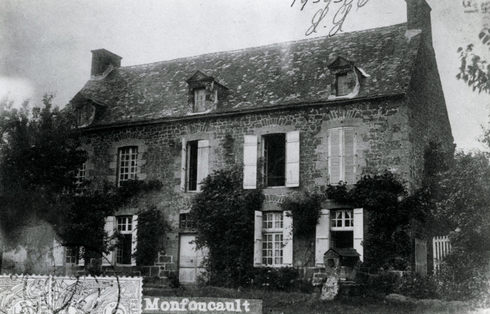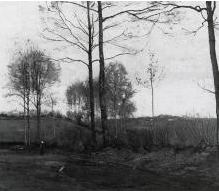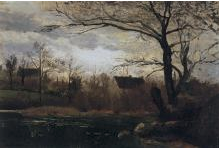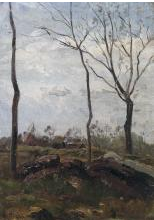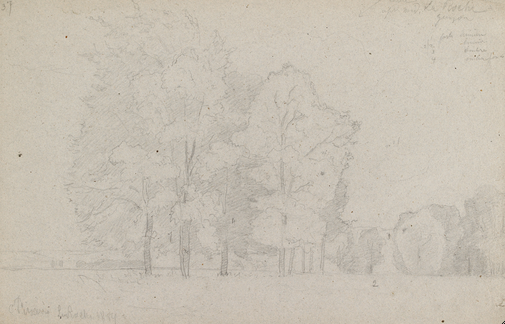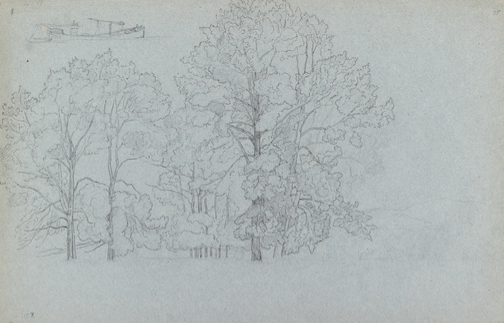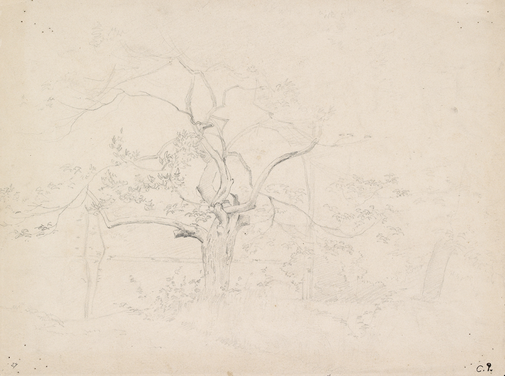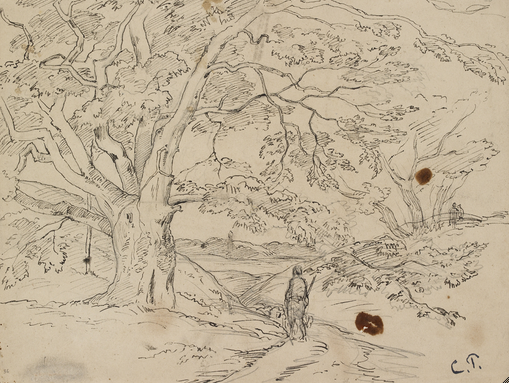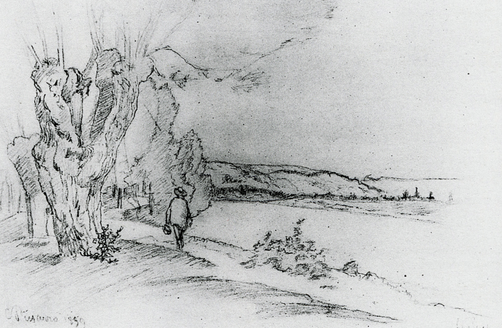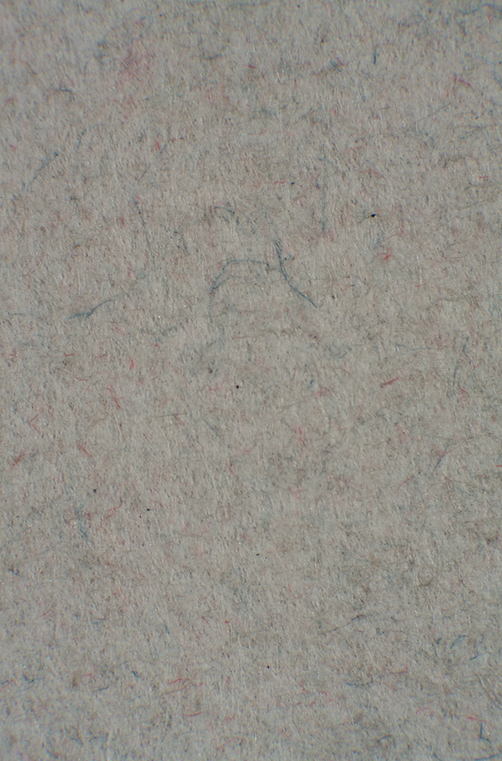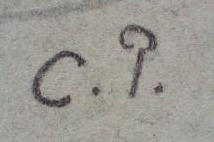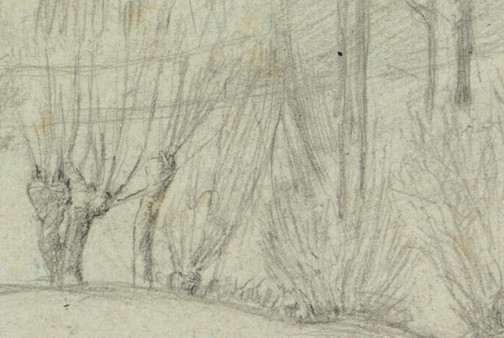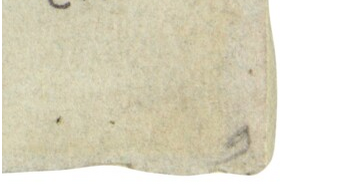Although Pissarro’s landscape drawings of the 1850s and 1860s count among the highlights of his career as a graphic artist, they have been little studied and are thus frustratingly difficult either to place or date. This sheet, a [glossary:graphite] drawing done in the manner of Camille Corot, has been dated as late as 1880 but was surely made early in the 1860s, when Pissarro first began to visit the farm of his friend and fellow anarchist Ludovic Piette, who lived in Mayenne, a small region bridging Normandy and Brittany (fig. 1.1). In fact, the single closest work in the Pissarro literature is Landscape in Montfoucault (fig. 1.2 [PDRS 97]), formerly in the collection of the painter’s son, Ludovic-Rodo Pissarro, who was named in memory of Piette. It seems likely that the Art Institute’s sheet is a product of Pissarro and Piette’s early friendship in the 1860s, as Pissarro’s first stay at Piette’s farm in Montfoucault took place sometime in the fall and winter of 1864; this is in keeping with the bare trees in this work and Pissarro’s painted depictions of the landscape, with their rich reddish-brown hues and trees bare of foliage (fig. 1.3 and fig. 1.4 [PDRS 96 and 98]). On this visit, Pissarro was accompanied by his wife and son Lucien, and what was planned as a brief trip ended up lasting six weeks, marking the beginning of a friendship that would see the Pissarro family return throughout the 1870s. Although the relationship between the drawing and the painting is not direct, the landscapes represented in each are so close as to secure identification of the site. Fortunately—especially in the absence of some defining architecture or topography—Pissarro inscribed the back of the canvas Étude faite à Montfoucault en 1864, crevée par les Prussiens et restaurée par mon ami A. Gauthier (Study done at Montfoucault in 1864, sliced by the Prussians and restored by my friend A. Gauthier).
The Art Institute’s sheet demonstrates Pissarro’s fascination with the structure of trees, and the timing of his first visit to Montfoucault facilitated precisely this kind of detailed study (see fig. 1.3 and fig. 1.4). The drawing can also be linked to other published landscape studies catalogued by Christopher Lloyd and myself and related to other known sheets discussed in the entries for those drawings. These earlier drawings—two identified as landscapes in La Roche-Guyon from the late 1850s and early 1860s (fig. 1.5 and fig. 1.6) and two others depicting similar topography (fig. 1.7 and fig. 1.8), and a dated La Roche-Guyon sketch (see fig. 1.9) that is very similar in its composition and natural topography—share features with the Art Institute’s sheet, namely the clean handling of lines reminiscent of Corot’s drawings from the 1820s and 1830s. Indeed, Corot was one of the nineteenth-century draftsmen that Pissarro greatly admired. Although it may be tempting to date the Art Institute’s sheet to the late 1850s or early 1860s, Pissarro made similar autumn landscapes during his 1864 stay at Piette’s farm. That fall the artist also appears to have heeded Corot’s advice from 1857 to go into the fields because the muse was there waiting in the woods.
The dominant motif throughout these early works is trees, recalling the compositions of the Barbizon school, particularly those of Corot and Théodore Rousseau. It is possible that Pissarro used a similar paper for these landscape studies, as the grayish-blue tonality of this sheet is comparable to that of the paper he employed for the two La Roche-Guyon sketches (fig. 1.5 and fig. 1.6; see Media and Support in the technical report). Both of these latter works are similar in size to this drawing, perhaps an indication that Pissarro sketched on larger sheets if using them as the matrix for the creation of subsequent paintings. The catalogue of Pissarro drawings from the Ashmolean Museum includes some other landscape studies from this period that are also comparable in size to this sheet, some of which were possibly reworked into paintings. Landscape in Montfoucault may have been used in this way as well, as the path and mountain range in the distance also appear in the related painting (fig. 1.2); Pissarro even placed a woman in the composition to highlight the trail clearly visible in the Art Institute’s sheet.
The delicacy of this drawing directly contrasts with the boldly hatched landscapes Pissarro did before his arrival in France in 1855 and his meeting with Corot shortly thereafter. It is a sheet marked by restraint, less the product of a brash young man than that of an artist trying to learn a discipline.
Richard R. Brettell
Technical Report
Technical Summary
Pissarro drew Landscape in Montfoucault in [glossary:graphite] on light-gray, handmade [glossary:laid paper]. He used fairly hard graphite to achieve fine details in the trees and foliage. There are touches of soft graphite throughout that appear much darker in tone. These are most noticeable in the bush in the center right area. The composition was drawn directly with no visible changes to the composition.
Media and Support
Support Characteristics
Primary paper type
Light-gray, medium-thick, slightly textured laid paper.
Paper fabrication
Chain line orientation and frequency
Horizontal, 2.7–2.8 cm.
Laid line frequency/cm
9–10 per cm.
Furnish
Fairly uniform, with some inclusion of red and blue fibers, and extraneous plant fibers such as bark (fig. 1.10).
Formation
Somewhat uneven, with a few small fiber clumps and several thinner circular spots (so-called papermaker’s tears), suggesting that it is likely handmade.
Other characteristics
A deckle edge is preserved along the bottom of the sheet. The remaining edges are trimmed straight. There are pinholes in the upper left, bottom right, and bottom left corners.
Dimensions
311 × 462 mm.
Preparatory Layers
No artistic surface alterations or coatings are visible in normal conditions or under magnification. Under ultraviolet ([glossary:UV]) radiation, there is a pale-yellow visible-light [glossary:fluorescence] overall on the paper surface that is characteristic of a light gelatin surface [glossary:size] or fixative. In specular light, fine spots of surface reflectance are seen scattered throughout the image area; some larger spots of surface reflectance are also visible at the center right side. There are numerous large spots that emit a bright yellowish-white visible-light fluorescence under UV radiation and are concentrated in the lower-left and center-right areas. These surface and fluorescence characteristics suggest the presence of a protein-based fixative such as gelatin, but they could also relate to condition (see Condition History).
Media Characteristics
The work was drawn in graphite. Pissarro used fairly hard graphite to achieve fine details in the trees and foliage. There are also touches of soft graphite throughout that appear much darker in tone. These are most noticeable in the bush in the center right area (fig. 1.11). No media is visible on the verso.
Compositional Development
No revisions or changes are visible in the composition under normal conditions or magnification.
Surface Treatment
No artistic surface alterations or coatings are visible in normal conditions, under UV radiation, or under magnification.
Condition History
The drawing exhibits some faint reddish-brown stains or [glossary:foxing] spots on the recto, most visibly in the center and center left areas. The paper appears to be slightly faded overall on the recto when compared with the tonality of the verso. There is an extraneous spot of red media in the center. The sides of the sheet are cockled.
Examination under UV radiation revealed numerous spots through the image area, ranging in size from 1 to 10 mm in diameter and concentrated in the lower left, center, and center right of the image, that emit a bright yellowish-white visible-light fluorescence. The spots are most concentrated on the verso and may relate to spots of fixative or [glossary:sizing], or possibly former fungal growth.
Kimberly Nichols

